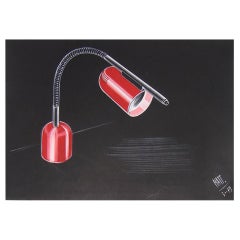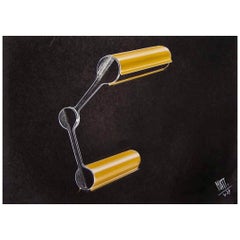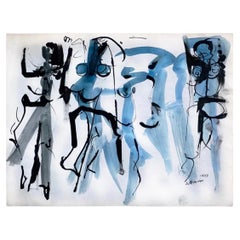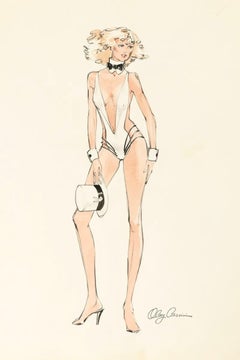Luciano Mattioli Drawings
Luciano Mattioli was a very versatile and prolific artist on the Italian and French design scene. He was a designer for Philips and Grundig and an exclusive designer in the 1970s for the Italian Company Girmi. Mattioli exhibited in Milan during the 1980s.
2
to
2
2
2
2
2
2
2
2
Height
to
Width
to
2
2
2
2
2
5
24
16
14
10
Creator: Luciano Mattioli
One 1979 Mattioli Italian Design Drawing for a Modern Red Desk Light Project
By Luciano Mattioli
Located in New York, NY
Dated mid-20th century industrial hand drawing, highly collectible Italian modern Product Design for a lacquer red desk light project, realized without a ruler in pastels and gouache...
Category
1970s Italian Mid-Century Modern Vintage Luciano Mattioli Drawings
Materials
Crayon, Paint, Paper
1979, Italian Design Drawing Sketch for a Desk Light Project by Luciano Mattioli
By Luciano Mattioli
Located in New York, NY
Dated mid-20th century industrial hand drawing, highly collectible Italian modern Product Design for a lacquer yellow desk light project, realized without ruler in pastels and gouach...
Category
1970s Italian Mid-Century Modern Vintage Luciano Mattioli Drawings
Materials
Crayon, Paint, Paper
Related Items
Midcentury Abstract Expressionist Ink Drawing on Paper by Salvatore Grippi, 1953
By Salvatore Grippi
Located in Brooklyn, NY
Midcentury abstract expressionist ink drawing on paper by Salvatore Grippi, 1953. Measures: 9.5" x 12".
This ink wash figurative abstract Expressionist piece on paper is signed by it...
Category
1950s American Mid-Century Modern Vintage Luciano Mattioli Drawings
Materials
Paper
H 1 in W 12 in D 9.5 in
White Bunny Drawing by Oleg Cassini for Playboy October 1979, Signed
By Oleg Cassini
Located in Brooklyn, NY
White Bunny Drawing by Oleg Cassini for Playboy October 1979, Signed.
Illustration of a woman wearing a white body suit, choker, and hat. Signed by Oleg Cassini. Notice the body suit is in the shape of the head of a bunny with clever use of the 'whiskers'.
Approximate Measurements: Length: 11" Width: 14"
Property from the Collection of Steven Rosengard, Chicago, Illinois
This original drawing was commissioned by Playboy and included in the October 1979 issue of Playboy Magazine (pages 225-227) in a feature that included works from designers such as Bill Blass, Oleg Cassini, Edith Head, Fernando Sanchez, and Monika Tilley, among others, who create their versions of the Playboy bunny costume. Candace Collins can be seen modeling some of the designs in the feature.
Oleg Cassini is an icon of twentieth-century fashion. Though born to Russian aristocracy and raised in Italy, he built a fashion empire that was unmistakably American. Cassini is perhaps best known for the hundreds of designs he created for First Lady Jacqueline Kennedy (see images 4-8), but his achievements as a collector, connoisseur, and quintessential twentieth-century man go far beyond Camelot.
In 1913, Oleg Cassini was born in Paris to the Russian diplomat Count Alexander Loiewski and Countess Marguerite Cassini, a Russian aristocrat of Italian ancestry who also had an interesting link to America. The daughter of Count Arthur Cassini, Russian Ambassador to the United States during the McKinley and Roosevelt administrations, Marguerite dazzled turn-of-the-century Washington as her father’s official hostess and left her mark on the capital city. Stationed in Denmark when the Russian Revolution toppled the czar, Ambassador Cassini and family were exiled to Switzerland before settling in Florence, Italy, where young Oleg was raised. A true Renaissance man, he spoke Russian, French, and Danish before adding Italian and English; he studied medieval and modern European military history and costume and learned to draw; he learned horseback riding, fencing, and the art of chivalry; and, most importantly, he came to understand the struggles of the Russian titled class and other European aristocrats in the wake of the Russian Revolution and World War I.
Countess Cassini started a successful fashion business in Florence, and soon the talented young Oleg was sent to Paris to sketch the latest collections for recreation in Italy. In Rome in his early 20s, Cassini created fashions for high society women and designed for a few films, which planted the seed for his move to Hollywood. The drive to reinvent himself brought Cassini to America in the 1930s; in his autobiography he describes arriving nearly penniless in mid-Depression New York City where his title as an exiled Russian Count meant even less than in war-devastated Europe. Down and out, Cassini struggled for employment, having sketching skills but no knowledge of the wholesale trade required for survival in Manhattan’s Seventh Avenue fashion district. However, he excelled at making connections, and Cassini slowly entered New York society. He was soon joined by younger brother Igor (who had studied in America and travelled with the young Emilio Pucci) and his parents, the once-dazzling Countess and his father, the displaced diplomat still loyal to Russia. The family settled in Washington, D.C., and Igor worked his way up the Hearst newspaper chain to become the famous society columnist Cholly Knickerbocker.
In New York, Oleg Cassini married the troubled socialite Merry Fahrney (who would go on to marry eight times), but the marriage ended in scandal for Oleg, and he decided to follow his original intention and head for Hollywood. Despite initial difficulties, Cassini gained access to Hollywood’s elite (partially through his skills on the tennis court), and was soon hired as a designer at Paramount Pictures alongside the redoubtable Edith Head. In her 1941 film debut I Wanted Wings, Veronica Lake wore a memorable Cassini design. That same year, Cassini met and married the newest young Hollywood star on the scene, the beautiful 20th Century Fox–talent Gene Tierney.
With the outbreak of World War II, Cassini enlisted in the Coast Guard but was transferred to the U.S. Army Cavalry which allowed officers of foreign birth. He attended basic training at Fort Riley, Kansas, and the horsemanship he learned as a boy served him greatly. He attended Officer Candidate School and reached the rank of First Lieutenant (he also became an American citizen at this time, losing his title of Count). Cassini spent several years posted at Fort Riley, where Tierney joined him before he landed a convenient military post in Hollywood. As Tierney’s career thrived (she played the title role in Otto Preminger’s Laura in 1944), she was able to assert her influence over 20th Century Fox’s head Daryl Zanuck, who hired Cassini as designer for Tierney on her 1946 film The Razor’s Edge, which proved to be a brilliant showcase for his talents. The pair separated the same year and, again seeking reinvention, Cassini re-established himself in New York City as a fashion designer. By 1950, the Oleg Cassini label was born.
Combining his knowledge of Old World and modern Europe, Hollywood, the tennis courts of Palm Beach and Newport, and of course, New York City, Oleg Cassini invented a new brand of fashion that was distinctly American and of its moment. For his first collection, Cassini took to the stage, narrating the looks and imbuing the scene with his personality, unusual in an industry where the designers typically remained backstage and the models were called by number over a PA. The first collection was a smash — the president of Lord & Taylor devoted all of their storefront windows to his designs — and by 1955 sales had reached $5,000,000. Oleg Cassini’s career had turned a very positive corner.
Cassini spent the early 1950s traversing the country, personally selling his collections to department stores in the interior, something his predecessors had never done, and moving between the Hollywood and New York scenes. Cassini’s brother Igor coined the term “the Jet Set” for this generation that constantly flew from New York to Los Angeles (then a ten-hour flight), Las Vegas, Paris, Rome, and the Riviera. In 1954, Cassini set out to woo Grace Kelly and sent her roses every day. The two were briefly engaged before her marriage to Prince Rainier of Monaco.
In December 1960, Cassini’s career-defining opportunity came when he was chosen by Jacqueline Kennedy to design her fashions for the White House. Cassini had long known Joe Kennedy and his war-hero son John, and had first met Jacqueline Bouvier before her marriage in the early 1950s. Invited by President-Elect Kennedy to meet Jacqueline at Georgetown Hospital (she had just given birth to son John Jr.) to present to her drawings of potential dresses and First Lady looks, Cassini worked furiously to prepare a new line for the First Lady. Mrs. Kennedy had always had her clothes made by the top French couturiers of the day, but for the White House she wanted an American designer. Cassini wrote in his autobiography that he told the First Lady: “‘You have an opportunity here,’ I said, ‘for an American Versailles.’ She understood completely what I was trying to communicate; she began to talk excitedly about the need to create an entirely new atmosphere at the White House. She wanted it to become the social and intellectual capital of the nation” (Oleg Cassini, In My Own Fashion, 1987, p. 327).
Mrs. Kennedy loved Cassini’s design for a gown to wear to the Inaugural Gala (she had already ordered a dress from Bergdorf’s for the Inaugural Ball), and Cassini was selected as the First Lady’s designer and was soon dubbed the “Secretary of Style.” From 1960 to 1963, Oleg Cassini would design over 300 items for Mrs. Kennedy, creating the “Jackie Look” that contributed not only to a fashion revolution but also the dawn of a new age. Cassini wrote that “Jackie played a very active role in the selection of her clothes. She loved brilliant colors — pistachio, hot pink, yellow, and white among others. Her sense of style was very precise; she would make editorial comments on the sketches I sent her. She always knew exactly what she wanted; her taste was excellent” (Oleg Cassini, In My Own Fashion, 1987, p. 334).
After the Camelot years, Cassini’s business flourished and grew into a major industry; his name appeared on everything from couture to tennis-, sport-, and swimwear, car interiors, housewares, and perfume. He collected beautiful and rare artwork, arms and armor, and antique furniture, and lived the lifestyle projected by his image. From this period onward, Cassini also came to live in important homes. Of his Gothic Gramercy Park townhouse on Manhattan’s 19th Street he would write imaginatively, “I walked into the foyer and immediately fell in love. It was a place unlike any other in New York, a sixteenth-century Dutch house transported brick by brick from Europe by the Wells Fargo family in the early twentieth century. There was a vaulted, twenty-foot ceiling in the living room, leaded windows, elegantly carved wood paneling...
Category
Mid-20th Century Italian Luciano Mattioli Drawings
Materials
Paper
Large Original Drawing by Gio Ponti for Touring Carrozzeria Milan, 1952
By Gio Ponti
Located in Dronten, NL
Important drawing by Gio Ponti of the Diamante line for Touring Carrozzeria Milan, documented in "Gio Ponti" "L'Arte si innamora dell'industria" by Ugo La Pietra, page 254-255. Ponti...
Category
1950s Italian Modern Vintage Luciano Mattioli Drawings
Materials
Paper
Free Shipping
H 11.03 in W 23.43 in D 0.04 in
Frank Dobson Modern Drawing Female Nude
By Frank Dobson
Located in Roma, IT
Red chalk drawing of a reclining Female nude
Signed and dated by Frank Dobson
This drawing, never before on the market, comes from an important European private collection and is beautified by an antique frame in gilded wood, in almost perfect condition.
The painting is also protected by glass
Dimensions whit frame cm 71 x 58.5
Every item of our Gallery, upon request, is accompanied by a certificate of authenticity issued by Sabrina Egidi official Expert in Italian furniture for the Chamber of Commerce of Rome and for the Rome Civil Courts.
Frank Owen Dobson (London 1886 – 1963) was a British artist and sculptor.
Dobson began as a painter, and his early work was influenced by cubism, vorticism, and futurism.
After World War I, however, he turned increasingly toward sculpture in a more or less realist style.
Throughout the 1920s and the early 1930s he built a reputation as an outstanding sculptor and was among the first in Britain to prefer direct carving of the material rather than modelling a maquette first.
The simplified forms and flowing lines of much of his sculptures, particularly his female nudes, showed the influence of African art.
From 1946 to 1953 Dobson was Professor of Sculpture at the Royal College of Art. He was elected to the Royal Academy in 1953.
While Dobson was one of the most esteemed artists of his time, is now seen as one of the most important British sculptors of the 20th century.
Dobson grew up in Clerkenwell where attended school in Forest Gate.
After eighteen months in Reynolds-Stephen's studio, Dobson moved to Devon and then to Cornwall where he lived, for two years, by selling landscape paintings.
In 1906 he obtained a scholarship to study at the art institute in Hospitalfield House in Arbroath and studied there for four years.
From 1910 to 1912 Dobson attended the City and Guilds of London Art School in Kennington, after which he returned to Cornwall. In Newlyn, he met Augustus John who used his influence and contacts and in, or around, 1915 Dobson created his first sculpture, a small piece in wood.
In 1915, during the First World War, Dobson enlisted in The Artists Rifles and served in France from October 1916.
In April 1918 he married Cordelia Clara Tregurtha.
Dobson was formally invalided out of the Army in November 1918 and by then had already submitted several drawings to the British War Memorials Committee. Dobson set up a studio in the Tregurtha family home in Newlyn but towards the end of the war he took a studio in Manresa Road in Chelsea and would live there until the start of the Second World War.
Throughout the 1920s Dobson focused increasingly on sculpture, exhibited work in several influential exhibitions and played a leading role in a number of artistic groups.
He was the only sculptor to take part in the 1920 Group X exhibition.
Dobson was a founding member of the London Artists Association and spent three years as President of the London Group between 1923 and 1927.
He made bronze portraits of several public figures.
At the Group X exhibition he exhibited two sculptures and studies of Ben Nicholson and his bronze head of H. H. Asquith was shown at the Leicester Galleries in late 1921.
Other subjects included Osbert Sitwell, Lydia Lopokova and Tallulah Bankhead. Dobson exhibited at the Venice Biennale in both 1924 and in 1926, was featured in the 1925 Tri-National Exhibition which visited London, Paris and New York and was also included in the 1926 European artists exhibition that toured America and Canada.
In March 1927 he had his first major one-man exhibition when the Leicester Galleries exhibited twenty-three of his sculptures and several bronzes.
In 1930 the Tate purchased a larger-than-life sculpture from Dobson and erected it outside the gallery on Millbank.
During the early 1930s Dobson continued to receive portrait commissions, most notably for Sir Edward Marsh and the actress Margaret Rawlings. Dobson worked in other media including textiles and silver, as well.
His silver gilt cup, Calix Majestatis, to mark the coronation of George VI and Queen Elizabeth is now in the Royal Collection.
During 1933 Dobson fractured his left arm which greatly limited his ability for heavy carving and his last monumental stone carving was to be Pax, which was first shown at the London Group in 1935.
At the start of World War Two, Dobson and his second wife [Caroline] Mary Bussell, whom he had married in 1931, moved to Bristol, where a large retrospective of his work was held in March 1940. Dobson lived in the city throughout the Bristol Blitz and like several other artists painted the ruins of churches destroyed in the bombing.
Dobson contacted the War Artists' Advisory Committee and offered his services as both a painter and sculptor.
WAAC were reluctant to offer sculpture commissions but eventually did offer Dobson a short-term contract for two portrait busts of Naval personal. Later WAAC commissioned some paintings, including one of workers arriving for work at a factory that had been relocated to a tunnel.
Dobson was appointed head of sculpture at the Royal College of Art in 1946, a post he held until his retirement in 1953.
For the Festival of Britain site on the South Bank of the Thames in 1951, Dobson created London Pride.
The sculpture was originally exhibited as a plaster cast but was later, after Dobson died, cast as a bronze and placed in front of the Royal National Theatre in 1987.
Among his last commissions were a bronze head of Sir Thomas Lipton and the zodiac clock...
Category
1930s British Modern Vintage Luciano Mattioli Drawings
Materials
Glass, Wood, Paper
Three Framed Drawings by Paul Chidlaw
Located in Chicago, IL
A set of three framed gestural drawings by Paul Chidlaw (1900-1989) depicting flocks of birds rendered in black ink on paper.
Paul Chidlaw was an earl...
Category
20th Century American Modern Luciano Mattioli Drawings
Materials
Paper
Abstract Expressionist Still Life Drawing on Paper by Salvatore Grippi, 1960s
By Salvatore Grippi
Located in Brooklyn, NY
Abstract expressionist still life drawing on paper by Salvatore Grippi, 1960s. Gorgeous colored graphite still-life on paper. Signed and dated. From artist’s estate.
Category
Mid-20th Century American Mid-Century Modern Luciano Mattioli Drawings
Materials
Paper
Framed Surrealistic Drawing by Pedro Friedeberg
By Pedro Friedeberg
Located in Atlanta, GA
Artist: Pedro Friedeberg (Mexican, 1936-)
Title:Le Tombeau D'Hemingway
Year: 1963
Medium: Ink and watercolor on paper:
Size: 14 3/4 x 19 1/2 plus 3 inch frame
Mark: upper lef...
Category
1960s Mexican Modern Vintage Luciano Mattioli Drawings
Materials
Paper
"American Indian Dance, " Art Deco Drawing by Jean Target, 1930s
By Jean Target
Located in Philadelphia, PA
Evidence of Western Europe's fascination with Native American culture, dress and way of life for over a century, this vivid drawing uses watercolor, gouache and crayon to capture a g...
Category
1930s French Art Deco Vintage Luciano Mattioli Drawings
Materials
Gouache, Watercolor
René Gruau, Sketch Bal du Moulin Rouge
Located in Encino, CA
René Gruau (1909-2004)
Original gouache on paper depicting Watusi in Frénésie at The Bal du Moulin rouge.
Signed on the back and titled " Moulin rouge XVIII "
Probably a preparatory ...
Category
1970s European Vintage Luciano Mattioli Drawings
Materials
Paper
Abstract Expressionist Ink Drawing on Paper by Salvatore Grippi 1953
By Salvatore Grippi
Located in Brooklyn, NY
This ink figurative abstract Expressionist piece on paper is signed by its creator, noted New York School artist Salvatore Grippi. Though undated, the piece is similar in form and st...
Category
1950s American Mid-Century Modern Vintage Luciano Mattioli Drawings
Materials
Paper
French Vintage Set of 9 Framed Figure-Study Sketches
Located in Baton Rouge, LA
This fantastic collection of 9 sketches were most likely composed in a figure study art class in France during the 20th century. Drawn with pencil on ...
Category
20th Century French Other Luciano Mattioli Drawings
Materials
Metal
Framed Figurative Drawing by Robert Henri Ashcan School
By Robert Henri 1
Located in Atlanta, GA
A framed pencil/charcoal drawing of a figure by Robert Henri (1865-1929). The work depicts an old man dons a cape and a hat and holds an umbrella, and is likely a study by the artist...
Category
Early 20th Century American American Classical Luciano Mattioli Drawings
Materials
Paper
Luciano Mattioli drawings for sale on 1stDibs.
Luciano Mattioli drawings are available for sale on 1stDibs. These distinctive items are frequently made of paper and are designed with extraordinary care. There are many options to choose from in our collection of Luciano Mattioli drawings, although black editions of this piece are particularly popular. Many of the original drawings by Luciano Mattioli were created in the mid-century modern style in italy during the 1970s. If you’re looking for additional options, many customers also consider drawings by and Gio Ponti. Prices for Luciano Mattioli drawings can differ depending upon size, time period and other attributes — on 1stDibs, these items begin at $500 and can go as high as $500, while a piece like these, on average, fetch $500.



